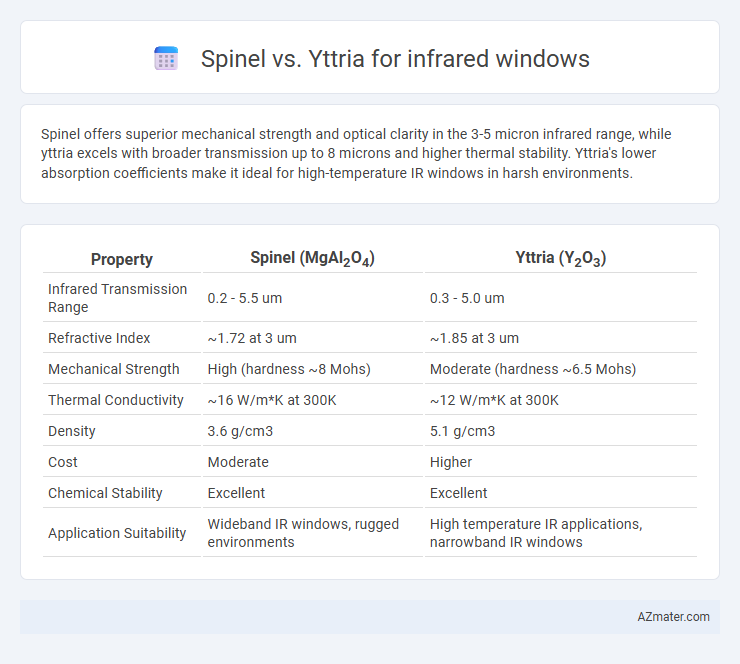Spinel offers superior mechanical strength and optical clarity in the 3-5 micron infrared range, while yttria excels with broader transmission up to 8 microns and higher thermal stability. Yttria's lower absorption coefficients make it ideal for high-temperature IR windows in harsh environments.
Table of Comparison
| Property | Spinel (MgAl2O4) | Yttria (Y2O3) |
|---|---|---|
| Infrared Transmission Range | 0.2 - 5.5 um | 0.3 - 5.0 um |
| Refractive Index | ~1.72 at 3 um | ~1.85 at 3 um |
| Mechanical Strength | High (hardness ~8 Mohs) | Moderate (hardness ~6.5 Mohs) |
| Thermal Conductivity | ~16 W/m*K at 300K | ~12 W/m*K at 300K |
| Density | 3.6 g/cm3 | 5.1 g/cm3 |
| Cost | Moderate | Higher |
| Chemical Stability | Excellent | Excellent |
| Application Suitability | Wideband IR windows, rugged environments | High temperature IR applications, narrowband IR windows |
Introduction to Infrared Window Materials
Spinel and yttria are prominent infrared window materials valued for their high optical transmission and durability in harsh environments. Spinel (MgAl2O4) offers excellent mechanical strength and broad infrared transparency from 0.4 to 5 microns, making it ideal for mid-wave infrared (MWIR) and long-wave infrared (LWIR) applications. Yttria (Y2O3) provides superior thermal shock resistance and transparency in the 2 to 10-micron range, often used in high-temperature and high-power infrared optical systems.
Overview of Spinel and Yttria
Spinel (MgAl2O4) is a transparent ceramic known for its excellent mechanical strength, high optical transmission in the 0.2 to 5 microns range, and superior thermal and chemical stability, making it ideal for infrared windows and domes. Yttria (Y2O3) offers exceptional transmission in the mid-wave infrared (MWIR) and long-wave infrared (LWIR) ranges with a broad spectral window from approximately 3 to 5 microns and beyond, alongside high refractive index and excellent thermal shock resistance. Both materials are extensively used in IR applications due to their transparency, durability, and ability to withstand harsh operational environments.
Optical Properties Comparison
Spinel exhibits high infrared transmission ranging from 0.4 to 5 microns with excellent thermal shock resistance and mechanical strength, making it ideal for harsh environments. Yttria offers broader infrared transparency extending up to 7 microns, coupled with a high refractive index and low absorption coefficients, enhancing infrared window performance in mid-wave and long-wave IR applications. Optical durability under high temperatures and resistance to environmental degradation are critical factors differentiating spinel and yttria in infrared window applications.
Transmission Range in the Infrared Spectrum
Spinel offers a broad infrared transmission range typically spanning 0.35 to 5.5 microns, making it suitable for applications requiring transparency from visible to mid-wave infrared wavelengths. Yttria extends further into the infrared spectrum, transmitting effectively from approximately 0.2 to 8 microns, which covers the visible to long-wave infrared regions. This extended transmission range often makes Yttria preferable for advanced infrared windows in thermal imaging and laser systems where longer wavelength transparency is critical.
Mechanical Strength and Durability
Spinel exhibits superior mechanical strength and durability compared to Yttria, making it a preferred choice for infrared windows in harsh environments. Its robust crystalline structure provides excellent resistance to abrasion, thermal shock, and mechanical stress, ensuring long-term performance under demanding conditions. Yttria, while offering good infrared transparency, generally has lower hardness and is more susceptible to fracture and wear, limiting its durability in high-impact or abrasive applications.
Thermal Stability and Operating Temperatures
Spinel exhibits superior thermal stability compared to yttria, maintaining structural integrity and optical clarity at temperatures exceeding 1200degC, while yttria typically operates reliably only up to around 1000degC. This higher operating temperature threshold makes spinel a preferred material for infrared windows exposed to extreme thermal environments, such as in aerospace and high-power laser applications. Furthermore, spinel's higher melting point and resistance to thermal shock ensure consistent infrared transmission without degradation under rapid temperature fluctuations.
Chemical Resistance and Environmental Suitability
Spinel offers superior chemical resistance compared to Yttria, making it more durable in harsh environments with exposure to acids, alkalis, and corrosive gases. Yttria exhibits good chemical stability but is more susceptible to degradation under extreme chemical conditions, limiting its use in aggressive atmospheres. In terms of environmental suitability, Spinel's robustness and resistance to thermal shock ensure reliable performance in a wide range of temperatures and humidities, whereas Yttria is better suited for stable, controlled environments due to its lower mechanical strength and chemical resistance.
Cost and Availability Analysis
Spinel and yttria both serve as durable infrared window materials with distinct cost and availability profiles influencing their selection. Spinel, derived from abundant natural sources with scalable synthetic production, offers moderate cost efficiency and widespread availability for commercial infrared applications. Yttria, while providing superior infrared transmission and thermal stability, involves higher material and processing expenses due to limited raw material supply and more complex fabrication techniques.
Typical Applications in Infrared Technology
Spinel is widely used in infrared window applications due to its excellent optical transparency from 0.3 to 5 microns and high mechanical strength, making it ideal for defense-grade sensor windows and missile domes. Yttria, with its outstanding transmission in the mid-infrared range of 3 to 5 microns and superior thermal shock resistance, is preferred in high-temperature environments such as infrared missile guidance systems and aerospace sensors. Both materials enhance infrared imaging performance but are selected based on specific wavelength requirements and environmental durability.
Selection Guidelines: Choosing Between Spinel and Yttria
Spinel offers exceptional mechanical strength and abrasion resistance, making it ideal for rugged infrared window applications subjected to harsh environments. Yttria provides superior thermal stability and excellent infrared transparency in the mid-wave IR range, suitable for high-temperature operations. When selecting between Spinel and Yttria, prioritize environmental conditions and wavelength requirements: opt for Spinel for durability in abrasive settings and Yttria for optimal optical performance under thermal stress.

Infographic: Spinel vs Yttria for Infrared window
 azmater.com
azmater.com